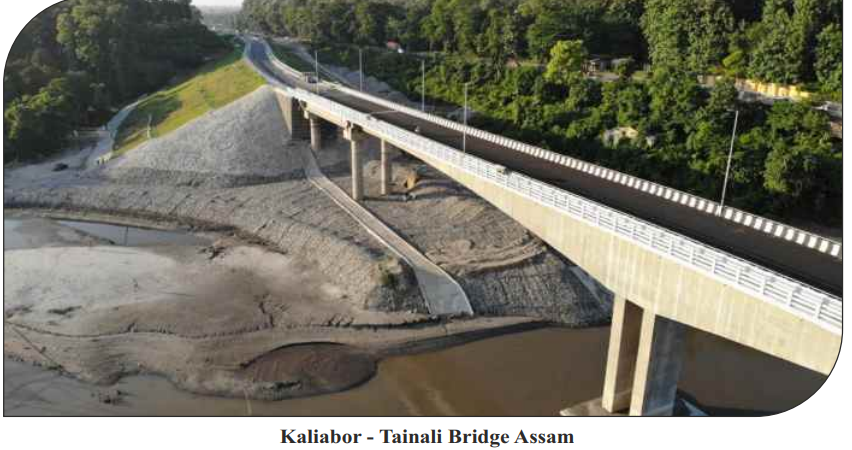The government under PM Narendra Modi in its first term has constructed 1,20,543 km of length of national highway. By 2019 it was the highest length of roads constructed by any government of post independent India. For comparison it surpasses the UPA led government under PM Manmohan Singh which constructed 92,851 km of length in their 10 years of tenure and also the NDA led government under PM Vajpayee which constructed 65,569 km of length.
The government constructs these roads under a scheme called Bharatmala Pariyojana . The constituents of this scheme is given in detail in this table. It is the annual report of 2022-23 from MORTH.
The Cabinet Committee on Economic Affairs approved the implementation of an umbrella
programme for the National Highways – “Bharatmala Pariyojana Phase-I” in its meeting held on 24th
October 2017, for construction/ up-gradation of National Highways of 34,800 kms length for 5 years (2017-18 to 2021-22). The program focuses on optimizing the efficiency of freight and passenger movement across the country by bridging
critical infrastructure gaps through effective interventions like development of Economic Corridors,
Inter Corridors, and Feeder Routes, National Corridor Efficiency Improvement, Border and
International Connectivity roads, Coastal and Port Connectivity roads and Green-field expressways.
Multi-modal integration is also built into this program. Special attention has been paid to fulfilling
the connectivity needs of backward and tribal areas, areas of economic activity, places of religious
and tourist interest, border areas, coastal areas and trade routes with neighbouring countries. The construction of 33,785 km has been completed as per the aim of this scheme. This data is as of December 2023.
Another major step that the Ministry took over was to connect the Northeast with highways and airports. The North Eastern region of India has seen drastic developments in terms of Road connectivity. The major ongoing Capital Road Connectivity projects in NER include an alternate two-lane highway from Bagrakote to Pakyong (NH-717A) (152 km) in the Sikkim-Kalimpong-Darjeeling region, four laning of Imphal–Moreh section of NH-39 (20 km), two laning of 75.4 km in Manipur, four laning of Dimapur-Kohima Road (62.9 km) in Nagaland, four laning of Nagaon bypass to Holongi (167 km) in Arunachal Pradesh and two laning of Aizawl–Tuipang NH-54 (351 km) in Mizoram.
Apart from that we also have to appreciate the right usage of money allocated for this ministry in every budget. The government is increasing its share of expenditure year by year. While the budget allocated in FY 2019-20 was Rs.78,248 Cr , the budget for the FY 2023-24 jumps up to Rs 2.8 Lakh Crores. The best part is that the government used about 50% of the budget in building quality highways. The ministry also helps in building the State highways and local roads under the Pradhan Mantri Grameen Sadak Yojna(PMGSY).
Other initiatives like Optical fibre connectivity, installing lights during the night time, opening a public digital platform to ensure a legal vehicle registration and driving license and to prevent corruption in this sector have revolutionized the Indian infrastructure. This ensured 'ease of doing business' in most parts of India including NE. International co-operations such as India - Japan joint working group , conference on safe mobility by the Asian Development Bank which gave a MoU(Memorandum of Understanding) to India with Bangladesh, Bhutan, Nepal, Myanmar and Thailand.
While the ministry outperformed in its second tenure , there are also some shortcomings such as road accidents and environmental concerns. The Annual Report on ‘Road Accidents in India” is published every year by the Ministry of Road Transport and Highways. As per the report, a total of 4,61,312 road accidents have been reported by States and Union Territories (UTs) in 2022 which claimed 1,68,491 lives and caused injuries to 4,43,366 persons. This marks an increase of 11.9% in accidents, 9.4% in fatalities, and 15.3% in injuries compared to the previous year. Of course, the ministry is trying to overcome this by introducing Road Safety Engineering. In this method, the ministry identifies what they call 'blackspots'. These black spots represent the road fatalities. It has been successful in clearing 399 out of 520 black spots identified this year.
The ministry is also trying to figure out how to be eco-friendly while constructing roads but that's a big topic and needs a whole new post itself.
Whew!! That's a lot of facts to digest right? But this is the improvement that we have made in the last five years in the Road and Transport Sector. A big chunk of credit goes to the Road and Transport Minister Nitin Gadkari who outperformed his work. If you want to see a detailed report of this ministry every year I would encourage you to go and check out the annual reports of MORTH. Here is the link -- https://morth.nic.in/annual-report.
Well, that's it from my side today. More posts will be coming soon. Until then Stay tuned :)
Bye!!





Nice analysis aniruddhan
ReplyDeleteThank you Joe:)
DeleteGood job! Very informative 👌
ReplyDeleteThank you
Delete